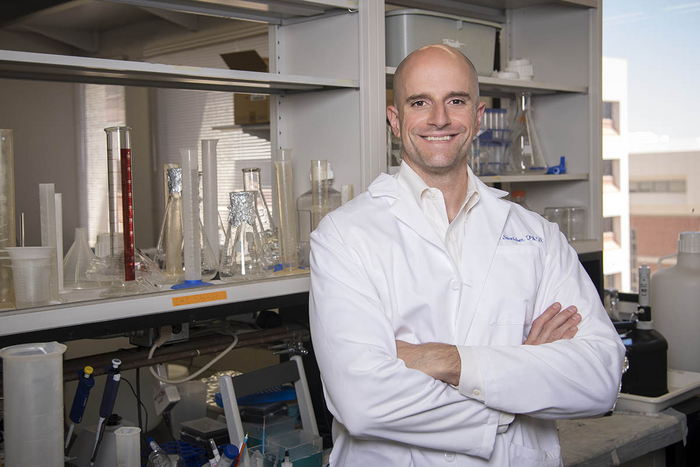TUCSON, Arizona — University of Arizona Health Sciences researchers are taking the foot off the brake in their quest to improve opioid therapy while decreasing its side effects.

Credit: University of Arizona Health Sciences
TUCSON, Arizona — University of Arizona Health Sciences researchers are taking the foot off the brake in their quest to improve opioid therapy while decreasing its side effects.
Led by John Streicher, PhD, a Department of Pharmacology associate professor in the UArizona College of Medicine – Tucson and a member of the UArizona Health Sciences Comprehensive Pain and Addiction Center, the researchers have expanded upon their previous research focused on one specific protein – heat shock protein 90 – and its role in opioid receptor activation and pain relief. Their prior investigations have found that inhibiting Hsp90 in signaling pathways in the spinal cord has an important role in enhancing the effectiveness and decreasing the side effects of opioid therapy.
Dr. Streicher’s research team has demonstrated that Hsp90 can prevent pathways in the spinal cord from producing the natural pain relief responses that they are designed to do in the body. To overcome this, they have been studying drugs that can inhibit the activation of Hsp90 in animal models. Their work has shown that using these inhibitors unblocks the pathway and provides another route for improved pain relief.
“Once we established the important role that this protein has in the spinal cord, we wanted to explore how it regulates pain,” Dr. Streicher said. “We have been digging further into the mechanisms that make this a druggable target so that we can more precisely translate it to the clinic.”
The new research published in Science Signaling, provides additional insight into one of the foundational mechanisms that supports the role of Hsp90 in pain relief. The study focused on adenosine monophosphate-activated protein kinase. AMPK is a protein that has been connected to pain and is the target of several drugs, including Metformin, an anti-diabetic medication.
Previous research has identified a relationship between AMPK and pain to suggest that activation of the protein reduces pain. However, Dr. Streicher’s research has found a new connection when it comes to modulating pain with opioid therapy: AMPK can act to block or reduce pain relief by opioids.
“There is a subtle distinction between modulating pain and, in our case, modulating pain relief by the opioids,” said Dr. Streicher, who co-wrote the manuscript along with Katherin Gabriel, PhD, who earned a doctoral degree from the College of Medicine – Tucson. “Our paper goes into detail figuring out what AMPK is doing, the neurons it is expressed in and generally what is causing it to reduce pain relief. This provides a mechanistic foundation for our translational work to develop drugs as real clinical treatment options.”
Dr. Streicher’s team found that one of the effects of using the Hsp90 inhibitors was that the drugs also helped to overcome an opioid-induced negative feedback loop regulated by AMPK. In this context, AMPK acts as a braking system to shut down the pain relief pathway and prevents the potential benefits of opioids. However, the Hsp90 inhibitors can disable this feedback loop, opening the door for increased effectiveness and lower dosage of opioids.
“I think of this negative feedback loop as one foot on the gas pedal and the other foot on the brake. If you put your foot a little heavier on the gas, things get activated. And if you put one foot on the brake a little bit harder, now you’re going slow down that activation,” Dr. Streicher said.
“In terms of opioids for pain relief, AMPK is the foot on the brake. When we inhibit Hsp90, we’re taking our foot off that brake and that allows us to enhance the efficacy of opioids.”
The findings are additional evidence that Hsp90 inhibitors could give doctors the opportunity to implement a dose-reduction strategy for patients. Less opioid drug could be prescribed, but patients would get the same levels of pain relief while experiencing lower side effects.
When an opioid such as morphine enters the body, it binds to a protein target called the mu-opioid receptor (MOR) and launches a series of effects known as a signaling cascade. As signaling molecules work their way downstream, some cause positive effects, such as pain relief. Others result in negative side effects, such as: respiratory depression, which can cause death; reward, which can lead to addiction; and tolerance, which can increase the quantity of drug needed to provide the same amount of pain relief.
In his lab, Dr. Streicher is continuing research into how Hsp90 works in the spinal cord to amplify the analgesic effects of opioids, including studying a previously unknown signaling circuit in the spinal cord that was discovered during a previous study. Working with the College of Medicine – Tucson’s Quantitative Proteomics Laboratory, Dr. Streicher and his team have identified more than 200 proteins that may provide additional insight on how MOR signaling is organized in the spinal cord.
The new findings could have further translational impacts for patients who use AMPK drugs, such as Metformin, for conditions like diabetic neuropathy.
“This is speculative, but perhaps one of the reasons it is very hard to treat these patients with opioids is because other medications that target AMPK are interfering with what the opioids are intended to do,” Dr. Streicher said.
The prospects for developing a clinical Hsp90-inhibitor drug are promising, as several cancer researchers are studying Hsp90 inhibitors and demonstrating strong proof-of-concept in the lab. Still, approval by the U.S. Food and Drug Administration is likely years away.
“The goal of our research is to understand how opioids and pain work and to develop the ability to make a drug that’s going to improve opioid therapy. This is another step in the path that gets us closer to making that a reality,” Dr. Streicher said.
This work was supported by an Arizona Biomedical Research Commission New Investigator Award #ADHS18-198875, a National Institutes of Health grant R01DA052340, and institutional funds from the University of Arizona.
Journal
Science Signaling
DOI
10.1126/scisignal.ade2438
Method of Research
Experimental study
Subject of Research
Animals
Article Title
HSP90 inhibition in the mouse spinal cord enhances opioid signaling by suppressing an AMPK-mediated negative feedback loop
Article Publication Date
11-Apr-2023




